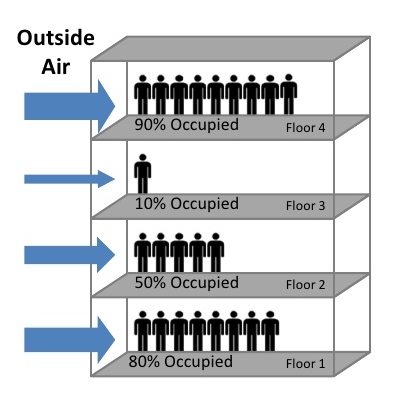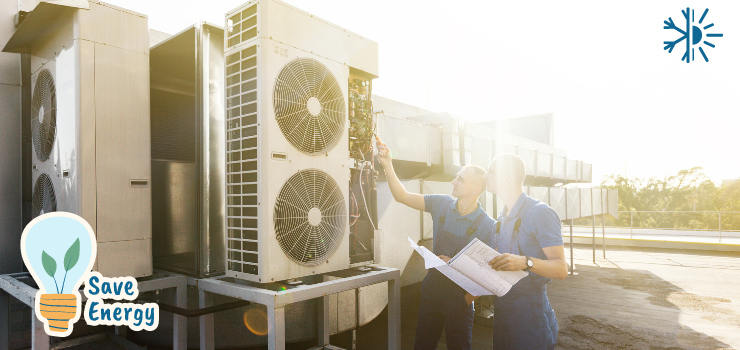Written by: Scott Lance, EBCP, LEED AP O&M – Regional Director.
There is a general course of controls firms preparing demand control ventilation (DCV), or CO2 control, in active buildings. DCV is typically instituted for energy reduction purposes, in some unique scenarios it is set up to alleviate an absence of outside air being presented for ventilation. However DCV for energy reduction is not as simple as lowering intake outside air at the air handling units (AHUs) based on building CO2 levels.
Normally, control firms provide CO2 sensors in the area or the return of air ductwork to an AHU. These are proper spots to witness CO2 levels for a whole building or building zone. However, where are the energy savings determined? The energy savings calculation is based on the decrease of outside air right at the AHU. The price per conditioned Cubic Feet per Minute (CFM) of air is figured out for heating and cooling. However, it is much better to take the readings at your energy sources, not at the point of use. Validating savings at the main energy sources will indicate savings at the point of use and will also consider energy failures at terminal units; if adjustments to the system are not correctly made, verified, or affected by change of seasons.
When a building or space is designed, there are many variables that are considered to calculate minimum outside air requirements. The primary factor is occupancy: the amount of people equals this much necessary fresh air. In selected cases, exhaust from the building needs to be contemplated. Restrooms, garbage rooms, kitchens, isolation rooms and even lab processes have devoted exhaust. Normally you don’t want your building exhaust to be higher than the building supply. This will trigger the building to be negatively pressurized and each time an outside door is unlocked in the winter season a cold draft will enter the building. This event does not go away when the door is shut, any opening in the building will pull outside air in. Although savings are shown on the AHU level, this is not the case on the terminal unit level. All the infiltration is being heated or cooled by VAVs, CUHs, Chilled Beams, etc.
How do you prevent this effect? It’s simple – add a building or zone pressure sensor to examine all the exhaust air flows. The pressure sensor is the quickest, cheapest and simplest solution to this issue. What happens is the return CO2 levels will be lower than setpoint, the controls will determine a new outside air minimum setpoint. But, when the building pressure gets too low, the calculation will decrease to maintain the building slightly positive. This will reduce drafts every time a door is opened and make sure doors close properly. We have all been in a building where doors almost slam shut, or the door cannot be shut due to building pressure. This ensures terminal equipment is not heating or cooling more load than specifically designed to condition and will make all the energy calculations at the AHUs accurate for the entire building or space.

Now building pressure is resolved, are there any other prospects for savings based on CO2? There are and that solution is in conference rooms, gyms, and other spaces that are not always fully occupied, but have high air flow needs. Normally, conference rooms are either not occupied, or are occupied to maximum capacity. A CO2 sensor in spaces like this can provide additional savings. When not inhabited the CO2 levels will decrease and the air flow entering the space can be decreased (outside air flow at the AHU serving the space can be lowered in some instances as well). Many group areas have the lowest air flow setpoint for occupied mode and a lesser setpoint for unoccupied (sometimes this can be zero).
If the air flow setpoint can be lowered during occupied mode (when not many people are in the space) and the room temperature setpoint is held, then let the room go below the design air flow setpoints. The outside air flow at the AHU serving the space with low CO2 will be decreased resulting in energy savings. Once inhabited, one or two things will happen, space temperature will increase, CO2 levels will rise, or both. In response, the VAV for that area will add air flow to preserve temperature or CO2 levels. The same strategy also functions in gyms, areas with office cubicles, and other group areas.
Leave any questions in the comments section!

